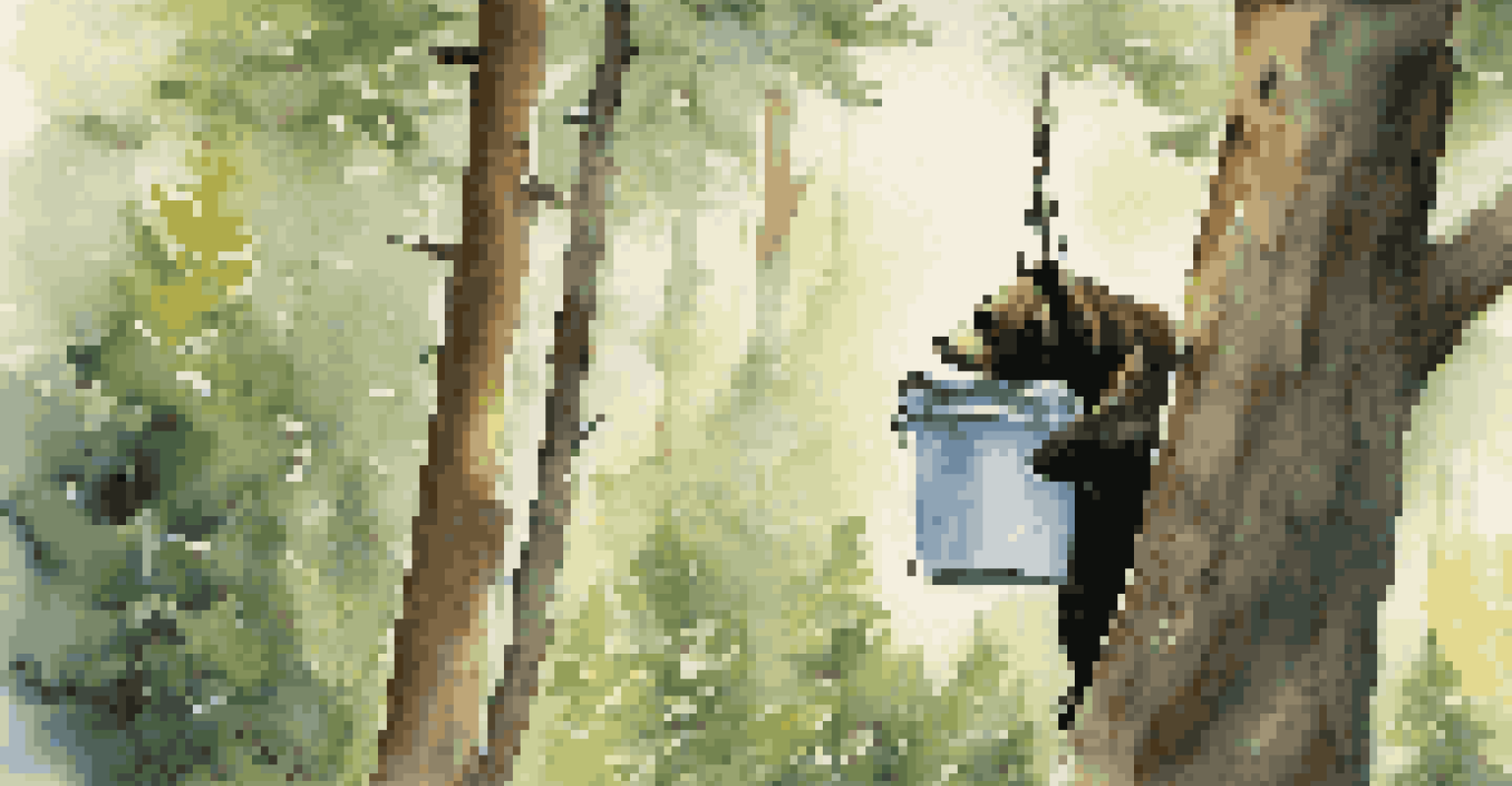Camping in Bear Country: Safety Tips and Precautions

Understanding Bear Behavior and Habitats
Bears are fascinating creatures, but understanding their behavior is crucial for safety. They are typically most active during dawn and dusk, so it’s important to be extra vigilant during these times. In bear country, you'll find both black bears and grizzly bears, each with unique habits. Knowing the differences can help you react appropriately if you encounter one.
The bear is a symbol of strength and courage, but also of vulnerability. It reminds us of the importance of respecting nature and its inhabitants.
Bears are usually shy and prefer to avoid humans, but they can be attracted to food, garbage, and even personal items. This attraction can lead to dangerous encounters, especially if a bear feels threatened or surprised. It’s essential to understand that a bear's natural instinct is to protect its territory and cubs. Therefore, maintaining a respectful distance is key.
During your camping trip, keep an eye out for signs of bear activity, such as tracks, droppings, or claw marks on trees. These signs indicate that bears are in the area, and you should adjust your precautions accordingly. Recognizing these signs early can help keep you safe and minimize unwanted bear encounters.
Choosing a Safe Campsite in Bear Country
Selecting the right campsite is your first line of defense against bears. Look for established campsites that are at least 200 yards away from bear trails, water sources, and berry patches, as these are common areas for bear activity. Avoid camping in dense brush, which can obscure visibility and make it harder to spot bears approaching your site.

When you set up camp, make sure to pitch your tent in an open area where you can see surrounding surroundings. This visibility will help you monitor for bears or other wildlife. Additionally, try to camp on higher ground if possible, as bears are less likely to venture into elevated areas. A well-chosen campsite can significantly reduce the likelihood of an encounter.
Understand Bear Behavior for Safety
Knowing when bears are most active and how to recognize their signs can help you avoid dangerous encounters.
Finally, always check local regulations regarding camping in bear country. Some areas may have specific guidelines on where to camp or requirements for bear-proof food storage. Familiarizing yourself with these guidelines not only enhances your safety but also helps protect the local bear population.
Proper Food Storage Techniques to Deter Bears
One of the most important aspects of camping in bear country is how you store your food. Bears have an incredible sense of smell, and even the smallest food scent can attract them from miles away. Always store food in bear-resistant containers or hang it from a tree at least 10 feet off the ground and 4 feet away from the trunk. This method prevents bears from easily accessing your food supply.
In every walk with nature, one receives far more than he seeks.
In addition to food, remember to secure any cooking equipment and toiletries that might carry food scents. Things like toothpaste, soap, and even some deodorants can attract bears. Store these items in bear-proof containers as well. If you’re unsure whether an item might attract a bear, it’s safer to store it away from your campsite.
After cooking, be sure to clean your cooking utensils and dispose of any food scraps properly. Avoid leaving any food waste around your site, as this can lure bears and other wildlife. By maintaining a clean campsite, you not only protect yourself but also reduce the chances of bears becoming overly reliant on human food sources.
Making Noise to Avoid Surprise Encounters
Making noise while hiking or moving around your campsite is a simple yet effective way to avoid surprising bears. Bears tend to avoid humans when they hear them coming, so chatting with your group, clapping, or even singing can help keep them at bay. This is particularly important in dense areas where visibility is limited.
Consider using bear bells or other noise-making devices attached to your backpack while hiking. These sounds can alert bears to your presence and give them a chance to move away before you get too close. It's a small effort that can significantly reduce the risk of an unexpected encounter with a bear.
Choose Campsites Wisely
Selecting established campsites away from bear activity areas significantly reduces your risk of an encounter.
Remember, though, that making noise is not a guarantee that a bear won’t approach. Always stay alert and be prepared to react if you spot a bear. By combining noise-making with other safety precautions, you create a multi-layered approach to bear safety.
Recognizing Signs of Bear Presence
Being aware of your surroundings is key to staying safe in bear country. Look for signs of bear presence, including claw marks on trees, diggings in the ground, and bear scat. These indicators can tell you if bears are nearby and help you decide whether to stay in the area or move on.
If you encounter bear tracks, try to determine the size and type of bear. This knowledge can help you gauge the potential threat level. For example, large tracks may indicate a grizzly bear, which may require different precautions than if you spot a black bear. Understanding these signs can provide you with valuable information.
If you do see a bear, remain calm and avoid direct eye contact, which they may interpret as a challenge. Back away slowly while keeping the bear in your sight, and make your presence known by speaking in a calm, firm voice. These actions can help de-escalate the situation and prevent a confrontation.
Using Bear Spray Effectively
Bear spray is a powerful deterrent that can help protect you in case of an encounter. It's essential to carry it in an easily accessible location, such as a holster on your belt or backpack. In a bear encounter, you only have a few seconds to react, so being prepared is critical.
When using bear spray, aim for the bear's face and spray in short bursts, creating a cloud between you and the bear. Make sure to practice the technique before your trip, so you know how to use it effectively if the need arises. It’s also important to check the expiration date on your bear spray; expired spray may not work as intended.
Store Food Properly
Using bear-resistant containers and securing all food-related items is crucial to preventing bears from approaching your campsite.
Lastly, remember that bear spray is a last resort. The best defense against bear encounters is preventing them in the first place by following all safety precautions. However, knowing how to use bear spray can give you peace of mind while you enjoy the great outdoors.
Emergency Procedures in Case of a Bear Attack
While bear attacks are rare, it's crucial to know how to respond in case you find yourself in such a situation. The first step is to stay calm and avoid panicking. If a bear approaches you, do not run, as this may trigger a chase instinct. Instead, stand your ground and speak to the bear in a calm, firm voice.
If the bear charges, it may be a bluff. Hold your ground and prepare to use your bear spray if it gets closer. In the unfortunate event of a bear attack, your reaction will depend on the type of bear. For black bears, fighting back is encouraged, while with grizzly bears, you should play dead if attacked.

After an encounter, it's essential to report the incident to local authorities. They can assess the situation and take necessary measures to keep other campers safe. Being prepared and knowing how to react can make all the difference in ensuring a safe and enjoyable camping experience.